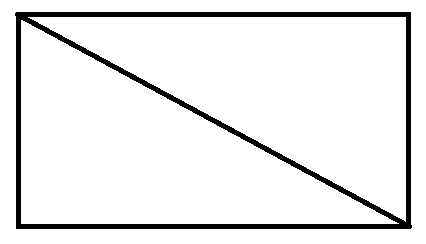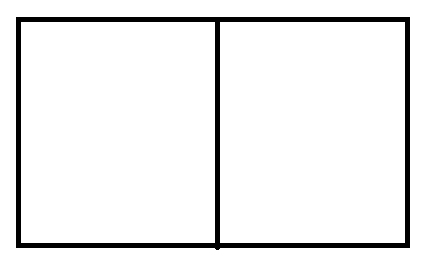
How can you make a quadrilateral rigid?
Answer
467.4k+ views
Hint: To do this question first we should know what is a rigid quadrilateral. There is a way to make a quadrilateral rigid. Add a cross brace connecting two parts of the quadrilateral, avoiding some non-rigid cases.
Complete answer:
Any quadrilateral is naturally non-rigid.
The simplest cross brace to describe that will render a convex quadrilateral non rigid is to add a line segment from one vertex to the opposite one. This will subdivide the quadrilateral into two rigid triangles.

Therefore, in this question, It is possible to make a quadrilateral rigid with a cross brace that connects a point on one side to another point on the quadrilateral, but this does not always result in a rigid structure.
For example, a line segment joining the mid-point of one side of a rectangle to the midpoint of the opposite side would not make the structure more rigid.

Therefore, On the other hand, if you have a line segment that runs from $\dfrac{1}{3}$ of the way along one side to $\dfrac{2}{3}$ of the way along the opposite side, then the resulting structure would be rigid.

Note: It is possible to make a quadrilateral rigid with a cross brace that connects a point on one side to another point on the quadrilateral, but this does not always result in a rigid structure. For example, a line segment joining the mid-point of one side of a rectangle to the midpoint of the opposite side would not make the structure more rigid.
Complete answer:
Any quadrilateral is naturally non-rigid.
The simplest cross brace to describe that will render a convex quadrilateral non rigid is to add a line segment from one vertex to the opposite one. This will subdivide the quadrilateral into two rigid triangles.

Therefore, in this question, It is possible to make a quadrilateral rigid with a cross brace that connects a point on one side to another point on the quadrilateral, but this does not always result in a rigid structure.
For example, a line segment joining the mid-point of one side of a rectangle to the midpoint of the opposite side would not make the structure more rigid.

Therefore, On the other hand, if you have a line segment that runs from $\dfrac{1}{3}$ of the way along one side to $\dfrac{2}{3}$ of the way along the opposite side, then the resulting structure would be rigid.

Note: It is possible to make a quadrilateral rigid with a cross brace that connects a point on one side to another point on the quadrilateral, but this does not always result in a rigid structure. For example, a line segment joining the mid-point of one side of a rectangle to the midpoint of the opposite side would not make the structure more rigid.
Recently Updated Pages
You are awaiting your class 10th results Meanwhile class 7 english CBSE

Master Class 7 Social Science: Engaging Questions & Answers for Success

Master Class 7 Science: Engaging Questions & Answers for Success

Class 7 Question and Answer - Your Ultimate Solutions Guide

Master Class 7 English: Engaging Questions & Answers for Success

Master Class 7 Maths: Engaging Questions & Answers for Success

Trending doubts
Convert 200 Million dollars in rupees class 7 maths CBSE

Full Form of IASDMIPSIFSIRSPOLICE class 7 social science CBSE

i What trees does Mr Wonka mention Which tree does class 7 english CBSE

What was the main occupation of early Aryans of rig class 7 social science CBSE

Write a letter to the editor of the national daily class 7 english CBSE

Repeated addition of the same number is called a addition class 7 maths CBSE





